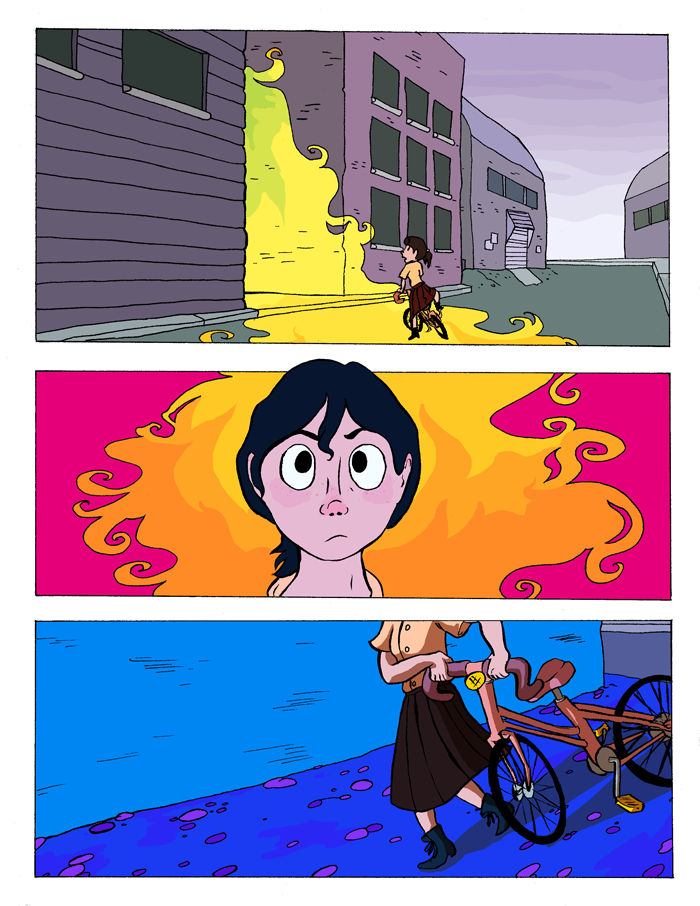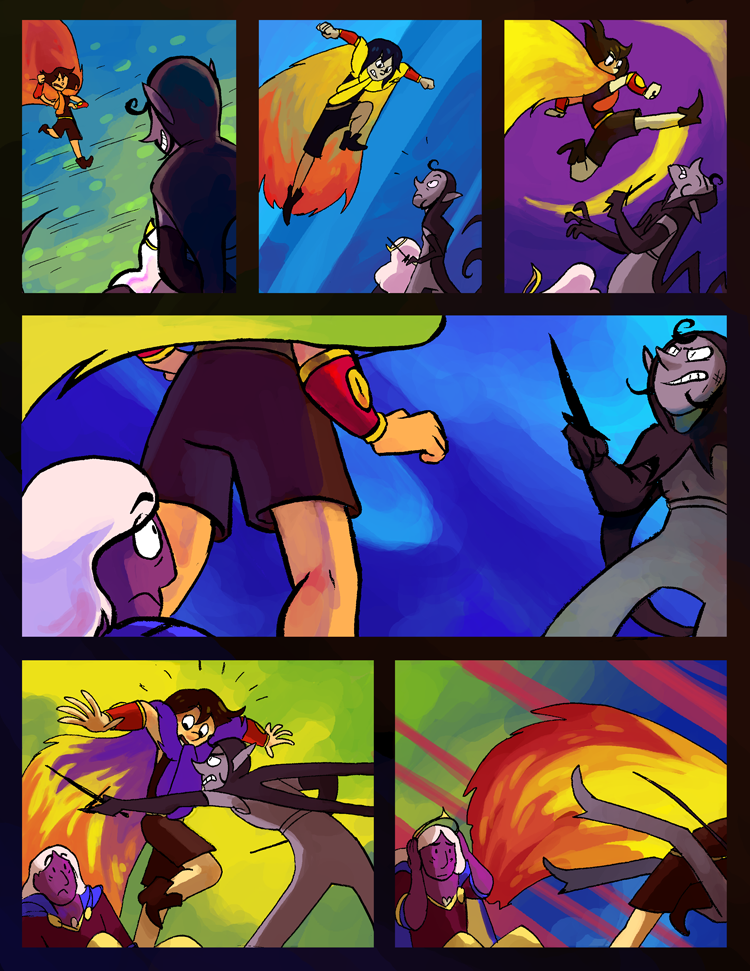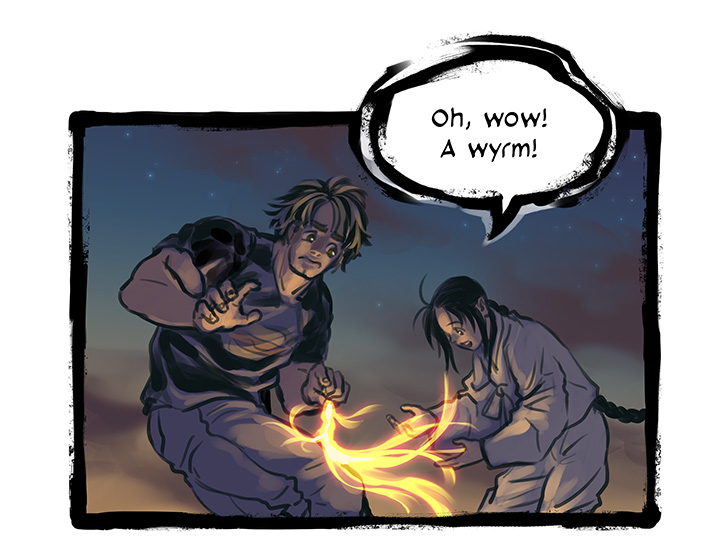Want The Next Hot New Idea?
 |
| From the Belfast Magical Federation |
Go Old School
You hear it a lot of late: There's no new ideas. You never see anything new these days.
And it does seem like the stuff put out by Hollywood follows a painful cycle of alien, vampire, zombie, alien, vampire, zombie, repeated ad nauseum.
 |
| From Neil Gamian's 'Sandman' series, Vertigo comics. |
Comics used to suffer the same unpleasant blandness until the Indie Explosion of the '90's. Now anybody at all can put out ideas. And yet we seem to have fallen into a new cycle of blandness: vaguely Medieval world, super-hero world, slice of life, repeat. On webcomic forums, I read the constant cry of the creatively blocked: 'I can't get any good ideas!'
And this is strange, because there is so MUCH fascinating material just waiting to be discovered and used to tell new stories. Our present culture floats like a little boat on a sea of stories, dreams and nightmares from eons past and cultures around the world.
So why does so little of it get used?
One word. Research.
In comics and visual media, there have been some attempts at digging deep into lore and coming up
with gems. Some have been amazing examples; Sandman, Fables, and Runaways to name a few. Others....well they've been less examples than terrible warnings. Supernatural, anyone? Yeah, let's not go there.
 |
| From the tv show 'Supernatural'. |
What Is Folklore?
In his book 'American Folklore', Richard M. Dobson describes Folk-Lore as 'the loving study of old customs, usages, and superstitions.' Myths are often included. But both folklore and myth have become cultural words for untruths; 'the myth of something' has become a synonym for 'the misconception of something.' Unfortunately, that can be true. But it's only one facet of folklore.

Folklore is the stories people in a culture build around themselves. Humans love stories, because they give us a sense that the world around us makes sense. Stories empower us; this is their universal and eternal attraction. There's power in knowing the story behind things. When we can't find an answer, we as a species will tell a story. And often, we'll find the answer to our question inside it.
Every culture around the world tells itself stories. Stories give us so much; a sense of belonging, comfort, lessons, warnings, coping mechanisms and advice on what to do when things go bad. Folklore often lets we humans cope with issues by putting them in more accessible and concrete forms that we can interact with: this is true from the ancient afreets of Egypt to Hexas in the Fern Gulley movie. Stories give us a way to understand. And this is where stories become important to comic artists.
People have been telling tales for a long, LONG time, and they've come up with ideas far more intricate, interesting and far-reaching than anything one person can come up with alone. The ideas to be had are endlessly engrossing, and many of them, neglected for political or social reasons in the decades past, are just waiting to be revitalized by the right creator. We've seen this recently in the explosive popularity of
Rejected Princesses, which researches, revives and tells the tales of women that were forgotten by mainstream culture. These stories are helping women to realize that, not only are they awesome now, but that they
always were. The world needs stories like these. The world needs stories that let us see other people in other ways of life as real and as valid as we are, and stories will let us do that in an entertaining, interesting and powerful way. We as creators just have to put in the work.
Stalking The Wild Story
If you're looking to plumb the depths of our world's folklore, there's a basic pattern to doing research on a concept or an idea. But there are minor variations based on where you start.
The main thing: read. Read everything. Even if you're making up your own folklore for your own world, see how other people have done it so you can do it right.
If you're at that fork in the road in research, here's a few map sketches for where to go.
I Have No Idea....
If you really want to do something but have no ideas yet, kill time by doing lots of life sketching. Go to the park, the coffee house, the woods, and sketch what you see. This will be time well spent. And while you're sketching, let your mind wander. Too often we're so frazzled and busy that there's no room in our brains for stories. The brain needs quiet time to play by itself. Give it that if you want ideas. And start reading.
There are some really great books of stories that will fire the mind, including:
I also really recommend podcasts for those who enjoy listening to something throughout their days.
Lore is the first on my list. By turns the podcast enchants, invites and terrifies you, but you always come away wiser. You never know what kinds of ideas you'll get listening to a tale.
Podfeed also has a great directory listing of podcasts
at this link.
I Have A Concept Or Theme But No Story...
This happens to a lot of people. Maybe you got offered a chance to submit a piece for an anthology. Maybe you want to tell stories that empower a group. Maybe you just really like a culture and want to explore it through your art. Okay, you've got a starting point! Now what?
Let's say you want to tell a story about...oh, a raven. Step 1 is to choose your direction. Are you going to go with the germanic-influenced English idea we Americans inherited about ravens: symbols of impending death, doom and decay?
Or what about the Chinook and Inuit idea that Raven brought the Sun to humanity and freed us from darkness?
Step 1: Google Up A MapGoogle is step 1. Google 'raven stories'. But please, for the sake of everything you love, make googling a FIRST STEP ONLY!!!!! This is where shows like 'Supernatural' and 'Charmed' fall flat on their faces. They do a quick google search, pick up an idea they like, and that's the end of it. They don't even research how unusual words are pronounced, and their well read audience spends the whole show shouting 'it's pronounced Sowen not Sam-hane you morons!' at the screen. Don't do that.
Start reading articles. Not blurbs, articles. If it doesn't have citations or references it's worse than useless. The internet has a lot of quasi-informational mythology sites and about half of them are DEAD WRONG on key information, but since they don't cite sources you can't check. Read stories about ravens until you bump into one you like. As you read, keep a notepad handy for jotting down things like region or group names, new vocabulary and concepts that could be useful.
Step 2: Follow The Trail
Read the resources that your first step garnered you, and branch out to read about the culture these stories are set in if it's not yours. Sometimes little details turn out to be important; for instance, remember the Pied Piper of Hamelin? 'Pied' is an old germanic word for multi-colored cloth, so as an artist if you were illustrating the character and drew him in a nice blue suit, you'd be wrong. The culture is insisting on the detail that he be in multi-colored clothes right in the title. In America we dye food green for St. Patrick's Day, but in Ireland that's a terrible faux pas because it references, for them, the stories of people dying of hunger with their mouths turned green from trying to eat grass. Missing details like this can be the difference between a relevant and informative story and a culturally insensitive one.
Step 3: Dig For Gold
Once you've got notes together, start the easy part: writing it! You've got so much information now, it's just itching to get out and be something!
Haha yeeeah you wish. Writing is hard. Drawing is hard. It's going to be hard. But it's going to be worth it. Keep your notes on hand and see what ideas come out. Try taking that raven and throwing him in new circumstances. Mix and match ideas, and maybe you'll end up with this: an ancient Cree legend about crows, a desperate need for making the world better and a gritty noir city. That, my friends, is 'The Crow', and it's a multi-million dollar multi-media concept by this point.
I Have A Character But No Concept...
"I have this character, they're really cool and I want them to do cool stuff but I don't have a story for them..."
Oh boy is this one familiar. I myself held on to a strange little character for YEARS waiting for the right story for her. This held me back from, you know, actually TELLING a story. Not a good thing.
Step 1: Put It Into Words
The hardest thing about the nebulous character driven ideas is that they have no roots. There's nothing to go on but the image of this character. They're more like perfect statues than ideas, and your job is to make them live and breathe and move. Let's say you want to tell a story about a puppy, and maybe about cruelty to animals, but not in a boring or preachy way and not in a way that's already been done. And you're stumped.
Okay, what has Puppy done? What does it want to do? Do you know? Or do you just want to draw a puppy? That's okay, but if so you need to know that.
Step 2: Give It Something To Eat
What've you read lately? Not a lot?
First problem.
If you can at all manage it, read a LOT of history and folklore. If you don't like to read, try podcasts or Youtube videos. I reccomend history as well because these are the stories of things that have happened, and the crazy chances that come out of millions of people interacting over thousands of years are a LOT more interesting than what any single person will come up with, as I said earlier.
Do you like a certain culture? Start getting all the videos and books on it. Let's say you like ancient Egypt. Read endlessly about it. Read about the animal-mummification factories employed to kill animals and turn them into offerings for the gods that were sold by temples to their worshippers. Put your character into what you've been reading, and you may find yourself ending by telling a powerful story about a jackal puppy who is taken as the avatar of the god Anubis to tell humanity that treating his favorite animal badly is NOT what he wants them to do. And if they don't listen, well, things could get messy!
Alternately, decide you want to do a gag-a-day piece about the pup. Carry a notebook, and jot down anything funny that happens during your day. For a while. A few months at least. Then sort through the ideas and find the good ones. THEN start drawing. Ideas first, concept art second.
I Have A Story But No Concept...
Boy and girl holding hands on the edge of a cliff. Boy has to save girl, because girl is dying. He saves. Happily ever after. But what's she dying from? Um....
These ideas are much the same as the no-story characters, and the same steps apply. Books of folklore are particularly appropriate aids in this case because they tell short, sharp conceptual stories that will help you gain focus. Try their stories on your idea like sets of clothes, until you find what fits. You may be surprised at how deep and sharp your story will become when it's based in myth.
 |
| From the Comic 'Fables' |
 Lessons To Learn
Lessons To Learn
Whatever you're doing with folklore, read it all. Learn it all. The more fertile the soil of your mind, the more ideas will spring from it.
Examples To Follow
There's a handful of really good comics and animated films based in folklore out there. The movies I most reccomend are 'Song of the Sea' and 'The Secret of Kells', 'The Rabbi's Cat' and 'The Prophet.' In fact the comic of
the Rabbi's Cat is also a good choice. as is the endlessly deep and lush
Habibi. The amazing Vertigo comic
Fables drops all our folktales into the nitty gritty big city,
A Redtail's Dream explores Swedish myth, magic and shapeshifting in style, of course the classic
Sandman Chronicles is a must, but there are also sources like the tongue in cheek
Hamlet and Juliet and
No Rest For the Wicked.
Breaking The Lore is also a really good choice.

 The biggest thing this comic is missing is time. Don't get me wrong, Pirouz is skilled, but you can tell when they rushed a bit. Sometimes you'll get pages that will make your jaw drop, like the one below. But the very next page will be underwhelming. I'd like to see the artist put equal focus into all their pages, because the heights they are capable of reaching are, if they were hit consistently, enough to fall in love with.
The biggest thing this comic is missing is time. Don't get me wrong, Pirouz is skilled, but you can tell when they rushed a bit. Sometimes you'll get pages that will make your jaw drop, like the one below. But the very next page will be underwhelming. I'd like to see the artist put equal focus into all their pages, because the heights they are capable of reaching are, if they were hit consistently, enough to fall in love with. Often the creator goes for an extreme version of the human face when displaying emotion, and that's not necessarily a problem...but the jarring dissonance in style is. When you've done detailed faces and then proceed to simplify without warning, the reader is left with the impression that corners were cut. I'd really like to see consistently detailed faces as a reader. A little more patience and attention to detail in the anatomy of the face and body both will be well worth it if you want to up your viewership.
Often the creator goes for an extreme version of the human face when displaying emotion, and that's not necessarily a problem...but the jarring dissonance in style is. When you've done detailed faces and then proceed to simplify without warning, the reader is left with the impression that corners were cut. I'd really like to see consistently detailed faces as a reader. A little more patience and attention to detail in the anatomy of the face and body both will be well worth it if you want to up your viewership.

























